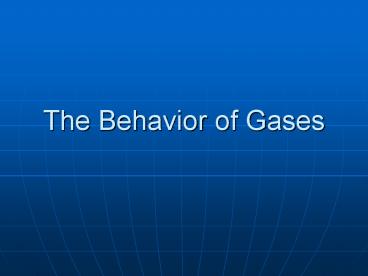The Behavior of Gases - PowerPoint PPT Presentation
1 / 30
Title:
The Behavior of Gases
Description:
The Behavior of Gases Properties of Gases (Review) No definite shape No definite volume compressible Kinetic Molecular Theory Basic Kinetic Theory of Gases Composed ... – PowerPoint PPT presentation
Number of Views:258
Avg rating:3.0/5.0
Title: The Behavior of Gases
1
The Behavior of Gases
2
Properties of Gases (Review)
- No definite shape
- No definite volume
- compressible
3
Kinetic Molecular Theory
moving
molecules
well supported ideas
4
Basic Kinetic Theory of Gases
- Composed of particles like atoms (ex He) or
molecules like (O2 and CO2) - There are no attractive/repulsive forces.
- Lots of empty space!!
5
Basic Kinetic Theory of Gases
- 2. Particles move in random, constant,
straight-line motion. - Move independently of each other.
6
Basic Kinetic Theory of Gases
- 3. All collisions are elastic meaning that KE is
transferred without loss of energy. - No change in kinetic energy.
- Gases tend to diffuse towards areas of lower
concentration.
7
Gas Pressure
- Pressure- force exerted on container walls by
particles in a gas - Units used- kPa, atm, Torr, mmHg
- STP (Standard Temperature and Pressure) Table A
- 273 K or 0C and
- 101.3 kPa 1 atm 760 Torr (mmHg)
8
Factors Affecting Pressure
Amount of Gas (number of moles) Increasing amount will increase P (and vice versa) Ex bicycle tires, car tires
Temperature Increasing temp. will increase P (and vice versa) Ex Tires deflate in winter
Volume Decreasing volume will increase P, increasing volume decreases P Ex press down on a balloon and it pops
9
- Pressure and volume have an inverse relationship,
if temperature remains constant. - If volume is increased, pressure is decreased by
the same factor.
10
Mathematically, the product of PV is constant or
PV k (where k is some constant).
Boyle Law P1 V1 P2 V2 P3 V3
11
Summary
12
- Volume and temperature have a direct
relationship, if pressure is held constant. - If temperature (K) is increased, volume is
increased by the same factor.
13
Mathematically, the relationship of volume
divided by Kelvin temperature is constant or V/T
k.
Charles Law V1 /T1 V2 /T2 V3 /T3
14
Summary
15
- Pressure and temperature have a direct
relationship, if volume remains constant. - If temperature (K) is increased, pressure will be
increased by the same factor.
16
Mathematically, the relationship of volume
divided by Kelvin temperature is constant or P/T
k.
Gay-Lussacs Law P1 /T1 P2 /T2 P3 /T3
Pressure
17
(No Transcript)
18
Combined Gas Law Equation
- P1 V1 P2 V2
- T1 T2
19
Combined Gas Law Equation
- Steps
- Determine which variable (if any) is kept
constant. - Cancel those terms and remove them from the
equation (Ex If the question says that
temperature remains constant the new equation
becomes P1V1 P2V2). - Plug in values that are given.
- Solve for the unknown.
- Be sure to always use temperature in Kelvins.
20
Ideal Gases vs. Real Gases
- Ideal gases behave as predicted by Kinetic
Molecular Theory. - Examples H2 and He
- Gases are most ideal at high temperature and low
pressure (also have low mass and low polarity).
21
- Real gases deviate from ideal behavior.
- Why?
- At low temps, gas particles become attracted to
each other (KMT says they are not). - Under high pressure, gases occupy a specific
volume (KMT says they dont).
22
Avogadros Law
- Avogadros number 6.02 x 1023
- Simply refers to the quantity of particles found
in a mole. - At STP, 6.02 x 1023 particles of a gas occupies
22.4 L. - At STP, 3.01 x 1023 particles of a gas occupies
11.2 L.
23
- Avogadro also hypothesized that equal volumes of
different gases at the same temperature and
pressure contain equal number of particles (or
equal moles).
24
Vapor Pressure
- In a sealed container, vapor pressure can be
measured above a liquid. - Evaporation occurs when some particles from the
surface of a liquid escape causing pressure to
build up above the liquid (not to be confused
with boiling).
25
(No Transcript)
26
Factors that Increase the Rate of Evaporation
- Heating a liquid (not to boiling point)
- Increasing surface area
- Create air currents
- (blow across the surface)
27
Liquid-Vapor Equilibrium
- Some of the gas particles condense and then we
find both evaporating and condensing occurs at
the same rate. - Rate of Evaporation Rate of Condensation
28
Related to Boiling
- Boiling occurs when the vapor pressure becomes
equal to the external pressure. - At normal atmospheric pressure, we call this
normal boiling point.
29
Boiling and Attractive (Intermolecular Forces)
- Boiling occurs when heat energy overcomes
attractive forces between molecules. - The stronger the intermolecular forces, the
higher the boiling point. - The weaker the intermolecular forces, the lower
the boiling point.
30
Table H
Notice, increasing temperature increases vapor
pressure. Line drawn at 101.3 kPa corresponds to
normal boiling point.































